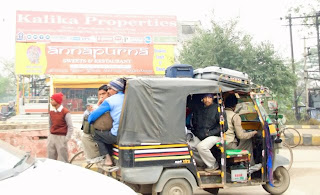Take the 2-wheeler, 3-wheeler and 4-wheeler.
All sorts of vehicles go on Delhi’s public roads. Even steam-rollers, horse-driven carts and the occasional cow make their way comfortably alongside the regular cars you’d expect in a big city.
The 2-wheeler is essentially a bicycle-rickshaw.
(Technically it’s got more than 2-wheels including the bicycle - but that’s a technicality).
It’s a great way to get up close and personal with Delhi’s insane traffic, familiarise yourself with how close pedestrians and vehicles interact with each other on the streets, and introduce yourself to Delhi’s foggy (read: polluted) air.
 |
| 2-wheelers at the front of a (disorganised) traffic junction |
It’s actually pretty exciting because you’re so close to everything. But I’d recommend taking it for a short distance. Your bum will thank you for it.
Hold on tight though! Make an adventure out of it.
The 3-wheeler is India’s version of the Thai tuk-tuks.
They feel a little safer because they’re more enclosed, and they definitely move faster than the 2-wheelers.
Although, outside the main part of the city, it’s a norm to squeeze as many people as possible into the 3-wheeler – the driver simply picks up and drops off folks along the way, and you just pay for your passage.
Everything goes - luggage on top, people hanging off the back...
The interesting thing to note is that all the 3-wheelers actually run on CNG!
The 3-wheelers also don’t have indicator lights – I saw a really creative 3-wheeler driver tie pieces of cloth to each side of the vehicle and raise the cloth to indicate he was changing lanes.
And the 4-wheeler is just a regular car. (It just sounded better to call it a 4-wheeler in line with the above 2 transport modes, but the locals really just call them cars. J )
Hire a car and a driver for a day to take you around Delhi’s sights. It’ll cost you less than 1,000 rupees for an air-conditioned car (yes, they do distinguish between AC and non-AC vehicles).
Chances are, you’ll end up with the Tata Indica (hatchback) or Tata Indigo (sedan). These are India’s answers to China’s Chery QQ and Malaysia’s Proton Saga.
And you’ll notice that every other car on the road along with you is a Tata too.


No comments:
Post a Comment